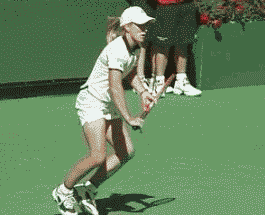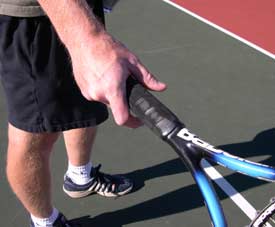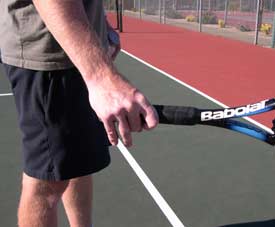|
TennisOne Lessons
The Essentials of Shot Making: Racquet Head Control Feisal Hassan, USPTA Master Professional With the increase in the speed of the game and racquet technology in the last few years, the training of racquet acceleration has become essential for the success of elite players.
Where does racquet acceleration fit into stroke fundamentals? The problem players and coaches are faced with is that an increase in racquet-head speed can easily lead to a decrease in control, negatively affecting a player's game. The goals of this article are to demonstrate a racquet acceleration and control training program which will lead to faster racquet acceleration; more control of the fast swing; and a better understanding by the players of their own game. The Racquet Acceleration and Control Training Program
Players only move to the next level once the previous level is mastered and automatic. Level 1: Relaxation and Swing Development Exercises
Purpose: to help players identify and feel which muscles are really used in swinging and which muscles need to be relaxed. The goal of this level is to teach players to swing effectively using as little effort as possible . Players generally tend to muscle the ball when trying to hit the ball harder instead of concentrating on moving the racquet head faster through the air. In order to swing at high speeds the player needs to learn to engage only the muscles needed and to relax all other muscles that could slow down the swing. The following exercises will help smooth out the player's swing: Heavy Racquet Drill Add weight to the racquet head. This could be done by keeping the racquet cover on the racquet and taking 6-8 swings with the cover on. As soon as this is done, the player removes the racquet cover and takes 6-8 swings at the ball without the racquet cover on the racquet. This drill has helped players feel the swing of the racquet. Breathing Players generally hold their breath when hitting the ball. I tell players to breath out on their forward swing. By doing this, it assists the player to relax the muscles. Three Finger Swing I tell players to think of using three fingers on their motions. Doing this helps players use a looser grip while still maintaining racquet control. For the forehand groundstroke, I have players relax the thumb and index finger and swing more with the other three fingers For the backhand groundstroke, serve and overheads, I tell players to relax their pinky and ring finger and swing more with the other fingers. Practice the above three exercises by feeding balls from a basket to the player ensuring the breathing and three finger swing is maintained. Once, and only once, players have mastered the above, do we move to level 2. Level 2: Pure Acceleration Exercises Purpose: To train the neuromuscular system in order to improve racquet acceleration.
There are two types of pure acceleration drills: Contrast drills and Racquet Head drills. These drills are designed to strengthen the muscles and to improve general neuromuscular coordination to achieve higher racquet head speeds. Control is not important at all in these drills. In fact, these drills will probably be more effective when executed off-court or against the back fence on the tennis court, so that players can focus on acceleration without worrying about control. Contrast drills Drills in which the players muscles are over stimulated and immediately under stimulated or vice-versa to force a faster than normal response. This effect is achieved by alternating the use of heavier and light object . Medicine Ball Drill Player throws a medicine ball 6-8 times (this throw mimics the stroke motion) at full speed followed by 6-8 hits (of the same stroke) at maximum speed. This is a set. Do 3-4 sets Badminton Racquet Drill Player swings 6-8 times with a badminton racquet followed by 6-8 hits with a tennis racquet at maximum speed. This is a set. Do 3-4 sets Racquet head drills Drills in which players practice swinging as fast as possible with the racquet head.
Ball Against the Net Drill Player swings hitting a ball into the net as fast as possible 6-8 times. Wait for 10 seconds and repeat 3 more times. Fast Feed Drill A coach or player tosses 6-8 balls to player “A”, who swings as fast as possible without letting the ball bounce, with little or no time given to the hitting player between hits. Repeat 3-4 times. Once a player has mastered level 2, then they move to level 3. Level 3: Combination Exercises Purpose: To train racquet acceleration as well as ball control, using spin as a tool. The control of a fast swing can only be achieved through the use of spin, predominately topspin. The player needs to master the use of spin in such away that the speed of the ball is mainly controlled through different types of spins instead of being controlled by different speeds of the hitting arm. A player should be able to maintain a fairly constant racquet-head speed while still controlling and changing the speed of the ball through spin. Drills to Improve the Feel of Spin This is achieved by players experiencing the feel of “brushing” up on the back of the ball. TIP: Press a ball against the net with a racquet. Tell the players to “brush” up on the ball to lift the ball over the net. TIP: Use a colored beach ball. Tell players to spin the ball so that the different colors on the beach ball rotate. Have the player use the palm of the hand and brush up the back of the beach ball to get the colors to rotate around. Once the player has the feel of the “brushing” up action, have the player hit a ball without spin (one flat ball), a ball with a little spin, followed by hitting a ball with a lot of spin (heavy topspin), while maintaining a constant high racquet-head speed. After this is achieved, have the player try to hit balls with different heights/racquet paths. This involves swing patterns specifically related to the path of the racquet head via the position of the wrist and arm. Once a player is in level 3, I want the player to understand how to apply racquet acceleration in singles match play situations. Baseline to baseline play situation There are three shots I like the player to be able to implement: the neutral, the offensive, and the defensive shot. Neutral (rally) shot The player plays this shot with two purposes in mind:
Racquet head technique: On the groundstrokes, the tip I generally give to players is to have the knuckle to ear at the end of the swing. Offensive (drive) shot This shot is faster with less topspin and but with more risk than the neutral shot. The goal is to pressure the opponent. Racquet head technique: On the groundstrokes, the tip I generally give to players is to have more of an outward swing with the hitting arm elbow and butt cap of the racquet pointing to the target area.
Defensive (loop) shot This shot should be played when the player tries to get out of a defensive position. The ball should land deep in the opponent's court. Racquet head technique: On the groundstrokes, the tip I generally give to players is to finish the swing over the hitting shoulder with the hitting arm thumb pointing down at the end of the swing. The mid-court ball at shoulder height situation Offensive (drive) shot The shot should be played fast and with little spin, trying to finish the point as fast as possible. Against a net player situation Sinking (dipping) shot This shot should travel a short distance and then drop quickly. The ball should be hit with a lot of spin and very little net clearance. Passing shots, angles and approach shots are examples of this type of shot. The racquet head technique is the same as the defensive shot, but brush up on the outside of the ball. Rhythm Drills The player trains the different shot variations using common rhythm drills (e.g.. crosscourt rallies, down-the-line rallies alternating crosscourt and down-the-line rallies).
Examples: Rally vs. rally: both players hitting cooperatively with an exchange of neutral (rally) shots Loop vs. drive: both players rallying cooperatively, with one player only hitting defensive (loop) shots while the other player attempts to hit only offensive (drive) shots Yes Vs. No Ball Drill: Both players have to call their intentions before the opponent's shot crosses the net. They will call, “NO” before hitting a neutral or defensive ball and “YES” before hitting an offensive shot. Errors are penalized with 2 points. Once again, these are drills where acceleration and control are equally important. They help players discover where acceleration and control are in balance (i.e. the maximum speed at which players can play and still maintain good control). Level 4: Pure Control Exercises Goal: Teaching players how fast they can accelerate the racquet and hit without making mistakes. 5's-In-A-Row Drill Player has to hit 5 loop shots, 5 rally shots and 5 drive shots in a row maintaining racquet acceleration and controlling all 15 shots. Target Training Drill Assign three targets for the player to hit: sharp angle, wide angle, and deep corner. Conclusion Trying to simultaneously develop racquet acceleration and control is a challenging task for any player. This Racquet Acceleration and Control Training Program is an example on how this might be achieved. The drills presented are some examples and should only serve as guidelines. Each player should try to develop a training program to fit his or her needs. I have had great success with this program. Keep in mind, a good Racquet Acceleration and Control Training program should always lead to the following:
Your comments are welcome. Let us know what you think about Feisal Hassan 's article by emailing us here at TennisONE
Feisal is currently the Director of Tennis at the Regency Sport and Health in McLean, Virginia. |





 Feisal Hassan, a USPTA Master Professional and PTR certified professional, is a member of the Head/Penn Racquet Sports National Advisory Board and National Speaker's Bureau, the Director of Certification & Testing for the USPTA Middle States division and a USA High Performance Coach.
Feisal Hassan, a USPTA Master Professional and PTR certified professional, is a member of the Head/Penn Racquet Sports National Advisory Board and National Speaker's Bureau, the Director of Certification & Testing for the USPTA Middle States division and a USA High Performance Coach.